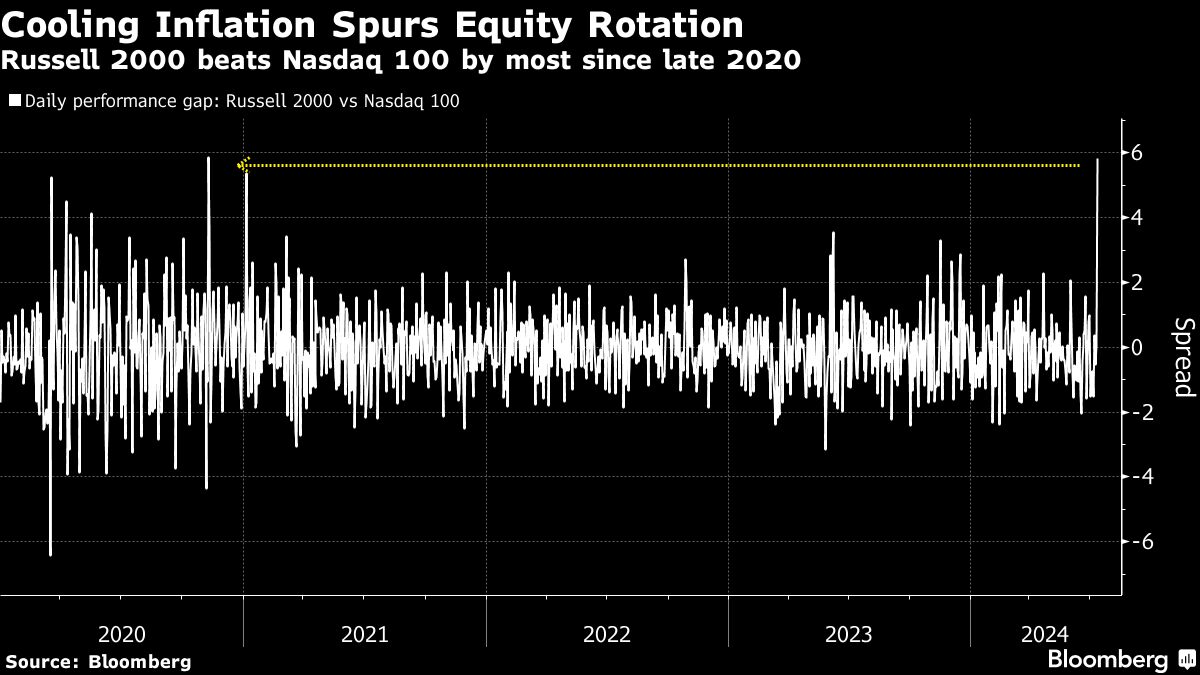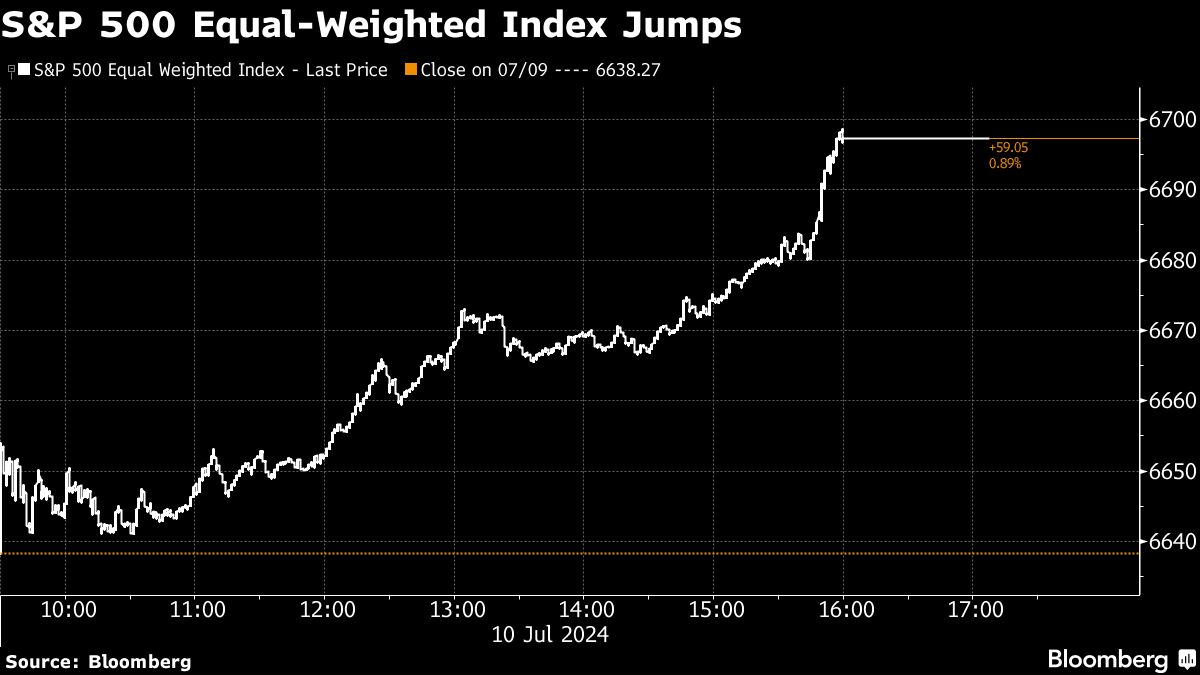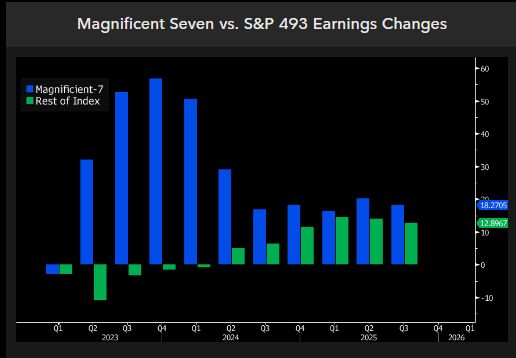
(July 12): Wall Street traders betting the Federal Reserve (Fed) will be able to cut rates soon sent bond yields tumbling — while driving a rotation out of the tech megacaps that have powered the bull market in stocks.
Further signs that inflation is slowing down fuelled speculation the Fed will be able to move as early as September. Optimism over lower rates sparked a shift into riskier corners of the market — as money exited the long-favoured safety trade of big tech. The Russell 2000 of smaller firms beat the Nasdaq 100 by 5.8 percentage points — the most since November 2020. While the S&P 500 fell nearly 1%, almost 400 of its shares went up.
To Callie Cox at Ritholtz Wealth Management, today could be a turning point for markets. It’s also a good reminder that diversifying is important.
“The big tech trade is turning on itself, yet the rest of the market is finally stepping in,” Cox said. “The S&P 500 is down today, but this is the best kind of selloff you could hope for if you’re a long-term investor.”
An equal-weighted version of the S&P 500 — where the likes of Nvidia Corp carry the same heft as Dollar Tree Inc — jumped. That gauge is less sensitive to gains from the largest companies — providing a glimpse of hope that the rally will broaden out.
The Nasdaq 100 sank 2.2%. A Bloomberg index of the “Magnificent Seven” megacaps slid the most since 2022. Tesla Inc plunged 8.4% on news it’s postponing its planned robotaxi unveiling to October. The rotation out of this year’s winners sent the iShares MSCI USA Momentum Factor Exchange-Traded Fund (ETF) slumping.
Conversely, the worst-performing sector in 2024 — real estate — had its best day this year. The Russell 2000 climbed 3.6% — the most since November. Financials rose as a group ahead of the start of the earnings season.
Treasury 10-year yields tumbled seven basis points to 4.21%. The dollar saw its biggest drop since May. Japan’s currency chief stuck with his strategy of trying to keep market players in the dark over whether Tokyo stepped in to prop up the yen after sharp moves.
US inflation cooled broadly in June to the slowest pace since 2021 on the back of a long-awaited slowdown in housing costs, sending the strongest signal yet that the Fed can cut interest rates soon. The so-called core consumer price index (CPI) — which excludes food and energy costs — climbed 0.1% from May.
To Chris Larkin at E*Trade from Morgan Stanley, July is still a longshot, but Thursday’s “Fed-friendly CPI” got markets one step closer to a September rate cut. A lingering question is whether this high-flying stock market has already priced in multiple cuts, he noted.
At Interactive Brokers, Steve Sosnick says that looking at the moves in the S&P 500 and Nasdaq 100 Thursday, one might eventually think that the “benign” CPI report was bad for stocks. In reality, he said, the data actually helped the vast majority of shares trade higher.
“We are getting a dose of the ‘healthy rotation’ that many have hoped for,” he noted. “One day does not a trend make. But as someone who has been advocating and hoping for a broader market rally and a rotation into value from growth, today’s activity makes me wonder if I should be more careful about what I wish for.”
Dan Wantrobski at Janney Montgomery Scott says Thursday’s market action showcases a notable improvement in overall breadth/participation.
“This fanning out from the narrow leadership areas (Magnificent Seven/artificial intelligence or AI/megacap) throughout much of this year is what we would like to see continue over the coming weeks and months in order to confirm a healthier expansion cycle on a longer-term basis,” he added.
“It’s a pretty swift reversal in the momentum trade, and that tends to benefit the laggards to a significant degree,” said Kevin Gordon at Charles Schwab. “No question it’s in response to the fact that the prospect of rate cuts helps companies that have been struggling in the ‘higher for longer environment.’”
Sosnick at Interactive Brokers warns, though, that a prolonged selloff in some of the biggest names could pressure the main indices that investors watch — even if the majority of stocks remain initially unscathed.
“That in turn could cause investors to lighten their exposure to key index-based investments, such as ETFs like SPY and QQQ,” he said. “If that occurs, then the selling could swamp the index as a whole, hurting the now laggard value stocks nonetheless.”
Neuberger Berman Group’s Steve Eisman expects the outsized strength in US megacap technology shares will “last for years,” as AI becomes more accessible to consumers via electronic devices.
“You have to own the big, large-cap tech stocks,” he told Bloomberg Television in an interview on Thursday. Eisman’s words attract notice on Wall Street because he made a name for himself with his “Big Short” bet against subprime mortgages ahead of the global financial crisis.
While forecasts for the “Magnificent Seven” remain robust, their earnings are expected to slow in the second quarter — just as the rest of the S&P 500 may finally post their first year-on-year growth in at least five quarters, according to Bloomberg Intelligence strategists led by Gina Martin Adams.
As the Wall Street banks kick off their second-quarter earnings announcements on Friday, investors are looking past another projected drop in net interest income — a key source of revenue for the lenders. Instead, they’re anticipating a rosy view on fee-generating businesses like investment banking and signals that at least some lenders see a rebound in loan profits.
JPMorgan Chase & Co, Wells Fargo & Co and Citigroup Inc start the earnings cycle on Friday morning, followed by Goldman Sachs Group Inc on Monday. Morgan Stanley and Bank of America Corp report next Tuesday.
Uploaded by Isabelle Francis




